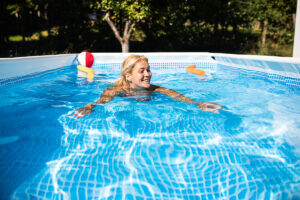
The appropriate depth of your backyard swimming pool is determined mostly by your particular circumstances, but there are some other things to consider as well.
When it comes to designing your dream backyard oasis, a swimming pool undoubtedly tops the list for many homeowners. Whether you envision lounging poolside with a tropical drink in hand or engaging in lively pool games with friends and family, the depth of your pool is a critical factor that influences both safety and enjoyment. But how deep should a backyard swimming pool be?
Safety First: Understanding Pool Depth Guidelines
Safety should always be a paramount concern when designing and building a swimming pool. The depth of your pool is directly linked to the activities you plan to enjoy within it, as well as the individuals who will be using the pool. To ensure the safety of swimmers and divers, pool depth guidelines have been established to minimize the risk of accidents and injuries.
For a residential backyard swimming pool, the general depth recommendations are as follows:
- Shallow End: The shallow end of the pool should have a depth of around 3 to 4 feet (0.9 to 1.2 meters). This depth is ideal for activities such as water aerobics, playing games, and providing a safe space for children to splash around under supervision.
- Transition Zone: Moving towards the middle of the pool, there is usually a gradual transition in depth. This area, often called the “transition zone,” typically ranges from 4 to 5 feet (1.2 to 1.5 meters) deep. It allows for more versatile activities and can accommodate swimmers of varying skill levels.
- Deep End: The deep end of the pool is where more experienced swimmers and divers can enjoy deeper water. It’s recommended to have a depth of at least 8 to 10 feet (2.4 to 3 meters) in the deep end. This depth is necessary for safe diving and underwater activities, as it reduces the risk of hitting the bottom or the pool walls.
Diving Deeper: Factors Influencing Pool Depth
While the general guidelines provide a starting point, there are additional factors to consider when determining the depth of your backyard swimming pool:
- Intended Use: Think about how you and your family will use the pool. If you’re primarily interested in casual swimming, relaxation, and games, a shallower pool might suffice. However, if you’re passionate about diving, water sports, or training, a deeper pool will be necessary.
- Diving Considerations: If diving is on your list of desired activities, pay close attention to the depth requirements for safe diving. A diving board or platform should only be installed if the pool’s deep end meets the recommended depth standards to prevent injuries.
- Local Regulations: Local building codes and regulations often dictate the minimum depth for residential pools, especially if you plan to install a diving board or platform. Ensure that your pool design adheres to these regulations to avoid legal issues in the future.
- Aesthetics and Space: The overall layout of your backyard and the aesthetic you’re aiming for can also influence pool depth. If you have limited space, you might need to compromise on the depth to ensure the pool fits comfortably within the available area.
- Budget: Deeper pools generally require more excavation and construction, which can lead to higher costs. Consider your budget constraints when planning the depth of your pool.
Finding the Perfect Depth
While safety guidelines and factors like intended use play a significant role in determining pool depth, remember that your pool’s design should align with your personal preferences and needs. Striking the right balance between safety, enjoyment, and aesthetics is key to creating a pool that brings joy to your family for years to come.
Do You Have More Questions About Spas? Ask Sunrise Premiere Pool Builders LLC
If you still have questions about how to build a brand new swimming pool, Sunrise Premiere Pool Builders LLC is here to help you. At Sunrise Pools, we can build and install your pool, spa, or hot tub and provide you with pool chemicals, services, and more. If you have questions, feel free to give us a call at 410-349-3852. To see more from us and for tips and tricks, be sure to follow us on Facebook, Twitter, Pinterest, and LinkedIn.
